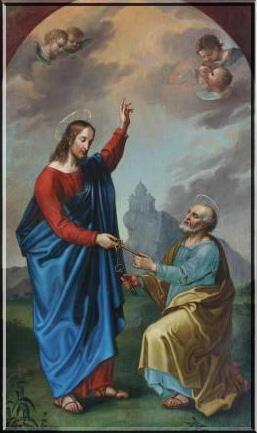
St. Peter, Apostle and First Pope
from The Lives and Times of the Roman Pontiffs, 1867
Saint Peter, the Prince of the Apostles, and first of the Christian pontiffs, was originally named Simon. His father was a fisherman of Bethsaida, near the lake of Gennesareth, in Galilee, which was also the birthplace of his brother, Saint Andrew. When Simon was about forty years old his brother presented him to our Saviour, who receiving him as one of His apostles, sumamed him Cephas, which in the Syriac signifies Stone, or Rock. Upon this Rock will build my Church, and the gates of hell shall not prevail against it. By these words our Saviour intimated that in raising Saint Peter to the dignity of the chief of the apostles, He made that dignity the foundation-stone of His Church.
As our Lord said that that edifice shall not be overturned, but subsist throughout all ages, it follows that the authority of Saint Peter has descended upon his successors, and that his See still continues, and ever will continue to be the centre of Unity. In order to be true members of the Church, the faithful must ever hold to it. Thus the fathers of the Church, and, following them, the theologians have ever reasoned. Heretics and unbelievers have, in vain, endeavored to obscure this truth. For some time Saint Peter did not habitually attend our Lord on his journeys, but always went to hear him when he taught the multitude. One day, Jesus was on the shore of the lake Gennesareth, which is also called the Sea of Tiberias, and knowing that Peter and Andrew had all night cast their nets in vain, he told the fishermen to go further out from the shore. They did so, and so abundant was the take, that not only their own boat, but also that of Saint James and Saint John was filled. 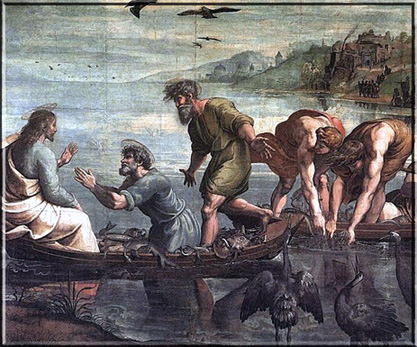
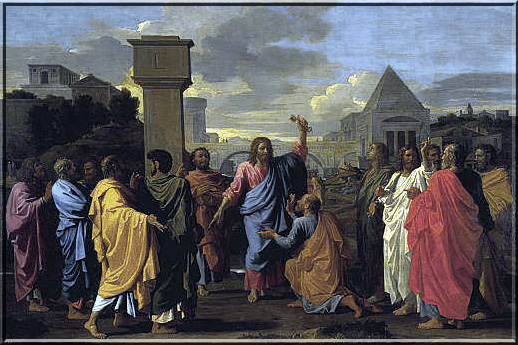
In the pages of the inspired Gospels we see Peter in his phases of man and apostle, until the apostolic spirit dominated the natural temper. His Master having reproved him for striking Malchus, Peter, timid and fickle, forgot his oath, but ere long bitterly bewailed his fault. After the death of our Saviour, Simon Peter hastened to the sepulchre. He was the first to enter. He found that Jesus was no longer there. Peter was also the first to whom, the Scripture informs us, Jesus appeared after his resurrection. Peter, however, was still to receive an express mission, more especially consecrating him to his apostolic functions. Jesus appeared to him and to John, when they both were engaged in fishing on the Sea of Galilee. 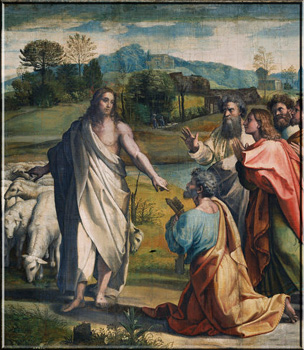 It was then and there that Jesus, after having thrice received from Peter the acknowledgment of his love, as though to make him expiate his triple denial, gave him a threefold charge of His flock in those words--Feed my lambs. Saint John, the beloved disciple, called Peter by the title of Apostle (Chap. xxi. 15-17), as having received from Jesus Christ, in reward of his attachment the Pastorate, which Saint Ambrose (on Luke xxiii.) so well entitles the Vicarship of Love. The gift of that function, as related by the Evangelist, was made at the very place where Jesus had given to Simon the name of Peter, which was afterwards confirmed to him by his calling to the government of the Church of Christ. Here Peter learned that, following Jesus Christ, he would suffer like him, and would be glorified in martyrdom.
It was then and there that Jesus, after having thrice received from Peter the acknowledgment of his love, as though to make him expiate his triple denial, gave him a threefold charge of His flock in those words--Feed my lambs. Saint John, the beloved disciple, called Peter by the title of Apostle (Chap. xxi. 15-17), as having received from Jesus Christ, in reward of his attachment the Pastorate, which Saint Ambrose (on Luke xxiii.) so well entitles the Vicarship of Love. The gift of that function, as related by the Evangelist, was made at the very place where Jesus had given to Simon the name of Peter, which was afterwards confirmed to him by his calling to the government of the Church of Christ. Here Peter learned that, following Jesus Christ, he would suffer like him, and would be glorified in martyrdom.Peter's first act of pontifical jurisdiction, after the Ascension, was the assembing of a council at Jerusalem, at which both the apostles and the disciples were present. The object was the filling, in the apostolic college, the place of the iniquitous Judas Iscariot. Matthias was chosen by lot. Peter presided over that assemblage, and reminded it that the crime of Judas had been foretold by David. 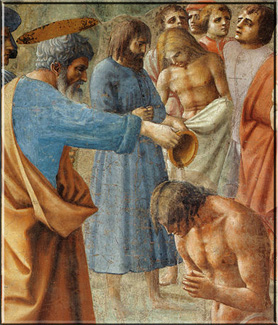 Peter's application of the Scriptures was again very felicitous when the disciples were visited by the wondrous phenomenon of the Day of Pentecost. On that memorable day, at about nine o'clock, a great sound, like unto the rushing of a mighty wind, filled the whole place of the assembly. All present saw, as it were, tongues of fire, and they all felt themselves filled by that Spirit which Jesus, on quitting them, promised they should be inspired with. In the fervor and gush of the zeal by which they were transported, their strange and eloquent language astonished the people of Jerusalem, and even the strangers who heard them. Some of the Jews took occasion to reproach them as being intoxicated.
Then Peter arose, and so earnestly preached Christ, risen from the dead, that three thousand persons were converted, and asked to be baptized. That discourse of Peter was at once wise and noble. The apostle announced that, in accomplishment of the prophecy of Joel, the time announced by our Lord had arrived (Joel, ii. 28, 30), and that the disciples were filled with that Spirit which he was to shed upon them, and upon his servants.
Peter's application of the Scriptures was again very felicitous when the disciples were visited by the wondrous phenomenon of the Day of Pentecost. On that memorable day, at about nine o'clock, a great sound, like unto the rushing of a mighty wind, filled the whole place of the assembly. All present saw, as it were, tongues of fire, and they all felt themselves filled by that Spirit which Jesus, on quitting them, promised they should be inspired with. In the fervor and gush of the zeal by which they were transported, their strange and eloquent language astonished the people of Jerusalem, and even the strangers who heard them. Some of the Jews took occasion to reproach them as being intoxicated.
Then Peter arose, and so earnestly preached Christ, risen from the dead, that three thousand persons were converted, and asked to be baptized. That discourse of Peter was at once wise and noble. The apostle announced that, in accomplishment of the prophecy of Joel, the time announced by our Lord had arrived (Joel, ii. 28, 30), and that the disciples were filled with that Spirit which he was to shed upon them, and upon his servants.In the second council seven deacons were appointed to assist the apostles in the distribution of alms, and in the ministry of preaching. It is remarkable how faithful the succeeding pontiffs have been to the first two precepts of Peter. From the date of the Ascension, Peter remained five years in Judea. At the gate of the Temple, on Mount Sion, he restored to health a poor cripple who asked him for charity. The Sadducees endeavored publicly to arrest Peter and John, who preached the resurrection of our Lord. The apostles, on the other hand, preached with redoubled courage; and Peter, previously so timid and halting in his ideas, no longer hesitated boldly to confess the name of Jesus before the assembled doctors of the law. 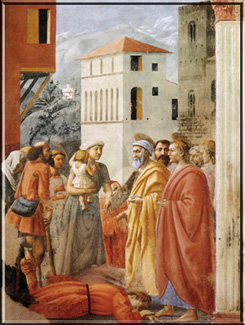 From that period dates the triumph of the Apostolic Church, persecuted from its birth, and reviving from its persecution. The punishment of Ananias and Sapphira, guilty of falsehood against both the sacredness of their oath and the spirit of Christianity, and a thousand other testimonies to the power which distinguished the life of Peter, served only to irritate his enemies. Notwithstanding the protection of Gamaliel, who was held in honor by all the people, that wise, prudent, and humane man, who wished to ascertain whether the apostles and their followers were not a party very different from any merely human faction, Peter and the apostles were beaten with rods, and even threatened with death. They bore their punishment with joy, and rejoiced in that they had been deemed worthy to suffer for the name of their Master. From that period dates the triumph of the Apostolic Church, persecuted from its birth, and reviving from its persecution. The punishment of Ananias and Sapphira, guilty of falsehood against both the sacredness of their oath and the spirit of Christianity, and a thousand other testimonies to the power which distinguished the life of Peter, served only to irritate his enemies. Notwithstanding the protection of Gamaliel, who was held in honor by all the people, that wise, prudent, and humane man, who wished to ascertain whether the apostles and their followers were not a party very different from any merely human faction, Peter and the apostles were beaten with rods, and even threatened with death. They bore their punishment with joy, and rejoiced in that they had been deemed worthy to suffer for the name of their Master.Then began a great persecution in Judea. Peter went to Samaria, which Saint Philip had already converted, to administer the rite of Confirmation to the faithful. It was there that he held his first dispute with the Samaritan, Simon the magician. 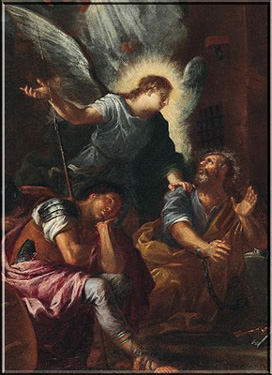 Thence he proceeded to Caesarea to baptize Cornelius the centurion, who commanded the garrison in that city. Cornelius was the first Gentile who received baptism. He subsequently became Bishop of Caesarea. From Palestine, Peter passed into Syria, to the metropolitan city of Antioch, the most famous city of the East, and considered as the third city of the Roman empire--after Rome and Alexandria. He took up his abode in Antioch in A. D. 38, and governed that See for several years. The more worthily to fulfil his pastoral duty, he frequently traversed the provinces of Pontus, Galatia, Cappadocia, and Bithynia. Eventually, while visiting the afflicted Church of Jerusalem, Peter was arrested by order of Herod Agrippa; but the apostle was miraculously delivered by an angel, who led him from the prison. That incident has been represented by the great Raphael, in one of his purest frescoes in the Vatican. Thence he proceeded to Caesarea to baptize Cornelius the centurion, who commanded the garrison in that city. Cornelius was the first Gentile who received baptism. He subsequently became Bishop of Caesarea. From Palestine, Peter passed into Syria, to the metropolitan city of Antioch, the most famous city of the East, and considered as the third city of the Roman empire--after Rome and Alexandria. He took up his abode in Antioch in A. D. 38, and governed that See for several years. The more worthily to fulfil his pastoral duty, he frequently traversed the provinces of Pontus, Galatia, Cappadocia, and Bithynia. Eventually, while visiting the afflicted Church of Jerusalem, Peter was arrested by order of Herod Agrippa; but the apostle was miraculously delivered by an angel, who led him from the prison. That incident has been represented by the great Raphael, in one of his purest frescoes in the Vatican.Peter, having placed Saint Evodius in the episcopal chair of Antioch, determined to proceed in person to Rome. Going through Naples, he planted the faith, by giving to that city Saint Aspren for its first Bishop. Arrived at Rome, the holy pontiff lived in the Trastevere, near the site of the Church of Saint Cecilia. In a short time, Pudens, a Roman senator, having heard the preaching of Peter, declared himself converted, and the Apostle was conducted to a fine palace which Pudens possessed upon the Mount Viminal. The capital of the world, says Feller (v. 41), appeared to Peter to be the best centre for the propagation of the divine religion of which he had become the chief minister; for Peter was not only the bishop of Rome, or of Antioch, but also the bishop of the Universal Church. Saint Paul, in his Epistle to the Romans (chap. xv. 20), while congratulating them on their faith, which he says is spoken of by all, tells them that he has long intended to visit them, but that he has been prevented from so doing by the law which he has laid down for himself, not to preach the gospel in places that had already received it, lest he should build upon the foundation of another. Saint Peter came to convert Rome, that great city "which," as says Saint Leo, "by its celebrity and its power had spread its superstitions throughout the earth, was now to become, in fulfilment of the designs of God, the humble disciple of the truth, and subsequently to extend its spiritual dominion beyond the bounds of its ancient empire." Qua eras magistra erroris, facta es discipula veritatis. Latius praesideres religione divina, quam dominatione terrena. Well may we ask, Has there been any sovereign in the world who has received a greater or more glorious title than that which was thus bestowed upon a man by God himself? According to the Diario, it was in the year 42 that the twenty-five years commenced that are commonly attributed to the pontificate of Saint Peter. He wrote at that time from Rome his first epistle, of which we shall speak hereafter. After seven years (being exiled by order of the Emperor Claudius), Saint Peter returned to Jerusalem, where he held the first council. He there first spoke upon the controversies which had arisen at Antioch between the heresiarch Cerinthus and the new converts. It was decided in that council that those converts were not to be disturbed; that it was sufficient that they should abstain from meat sacrificed to idols, and from fornication. That decision was sent to Antioch with this formula, since adopted by the general councils: Visum est Spiritui Sancto et nobis,--"It appears to the Holy Ghost and to us." The exile of Saint Peter lasted five years. After the death of the Emperor Claudius, the Apostle, in the year 56, and the fourteenth of his pontificate, returned to Rome, and there found Simon the Magician, who arrogated to himself the power of God, saying, "I command the angels," and who declared that the gift of working miracles might be purchased with money. It is known how the prayers of Peter obtained the victory over Simon, and how the latter broke his limbs near the temple of Romulus, now the church of Saints Cosmas and Damian. The Catholics of Rome perceiving at length that Nero meditated a persecution, entreated the Apostle to conceal himself from the pursuit of that monster of cruelty. Saint Peter left the city by the gate which is now called Saint Mary ad passus, on the Appian way. 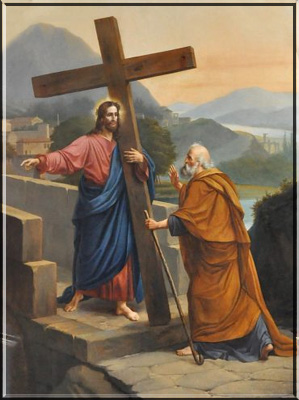 There he was met by Jesus. Saint Peter asked whither he was going. Jesus replied, "I am going to Rome, to be crucified again." Then Saint Peter understood that Jesus would be crucified in the person of his servant. Saint Peter then retraced his steps to Rome, determined to endure whatever torment the barbarous Nero might invent for him. Near the gate which leads to Saint Sebastian, there is a little round temple, dedicated to the memory of that apparition, and called Domine quo vadis,--Lord, whither goest thou? It has also the name of Saint Mary de plantis, because where Jesus replied to Saint Peter, he left the trace of His sacred feet, upon a stone still preserved in the Church of Saint Sebastian. Scarcely had Saint Peter re-entered the city when he was arrested and taken to the Mamertine prison. There he remained chained during nine months. The chain was found A. D. 126, by Saint Balbina, and then given to Theodora, a noble Roman lady, sister of Saint Ermes, who was then governor of the city, but who gloriously suffered martyrdom. Shortly afterwards, Theodora gave that chain to Sixtus I., martyr; it was placed in the Church of Saint Peter ad vincula, after it was restored by Eudoxia, wife of the Emperor Valentinian III., under the reign of Pope Sixtus III., about the year 439. There he was met by Jesus. Saint Peter asked whither he was going. Jesus replied, "I am going to Rome, to be crucified again." Then Saint Peter understood that Jesus would be crucified in the person of his servant. Saint Peter then retraced his steps to Rome, determined to endure whatever torment the barbarous Nero might invent for him. Near the gate which leads to Saint Sebastian, there is a little round temple, dedicated to the memory of that apparition, and called Domine quo vadis,--Lord, whither goest thou? It has also the name of Saint Mary de plantis, because where Jesus replied to Saint Peter, he left the trace of His sacred feet, upon a stone still preserved in the Church of Saint Sebastian. Scarcely had Saint Peter re-entered the city when he was arrested and taken to the Mamertine prison. There he remained chained during nine months. The chain was found A. D. 126, by Saint Balbina, and then given to Theodora, a noble Roman lady, sister of Saint Ermes, who was then governor of the city, but who gloriously suffered martyrdom. Shortly afterwards, Theodora gave that chain to Sixtus I., martyr; it was placed in the Church of Saint Peter ad vincula, after it was restored by Eudoxia, wife of the Emperor Valentinian III., under the reign of Pope Sixtus III., about the year 439.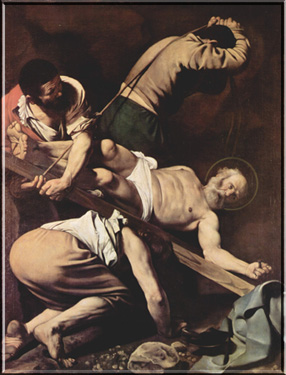 Saint Peter was violently tormented in the Mamertine prison, where he was confined with Saint Paul. From the prison Saint Peter was taken to the Janiculum, and was then put to death. He obtained it as a special favor from the executioner that he was to be crucified with his head downward, deeming himself unworthy to be placed on the cross in the same position as His divine Master had been.
Saint Peter was violently tormented in the Mamertine prison, where he was confined with Saint Paul. From the prison Saint Peter was taken to the Janiculum, and was then put to death. He obtained it as a special favor from the executioner that he was to be crucified with his head downward, deeming himself unworthy to be placed on the cross in the same position as His divine Master had been.According to the opinion of Baronius, of brother Sangallo, and of Novaes, Peter suffered martyrdom in the year of our Lord 69. The Diario, already quoted, gives the date of 65; but if, as has been expressly said, the twenty-five years of Saint Peter's pontificate only commenced in the year 42, it must at least be admitted that his death took place in the year 67. We will not insist upon this point of history, for a whole host of Dissertations have been written about the one and the other date. The most distinguished names, and the most respectable traditions have been quoted on either side. We have deemed it incumbent upon us to cite the date which is given by Novaes, supported by Baronius, and also that which renders the Diario consistent with itself. The body of Saint Peter was at first interred in the catacombs, and then transferred to the Vatican. His head, as well as that of Saint Paul, is over the high altar of the Basilica of Saint John of Lateran, where they were placed by Pope Urban V., A. D. 1370. The death of Saint Peter irrevocably fixed at Rome the chief See of the Christian Church. Henceforth Rome has become the Jerusalem of Christianity, the residence of its principal pastor, the centre of the Catholic union, the oracle and the rule of the various Churches, from which the fathers and the theologians of all ages have asked decisions upon all difficult matters, where the artifices of so many sectaries have been confounded, who have endeavored to alter the doctrine of Jesus Christ; there their mission has been received by all those apostolic men who, after the first publication of the gospel, have carried that divine light to the distant nations. It is not to be wondered at that the fury of the heretics, and the sarcasms of bad Catholics have always, but especially in this last century of turmoil and error, been directed against that great mother of the Christians; nor are we to be surprised that they have united their efforts to misrepresent as the mere result of human policy the authority that the Roman pontiff exercises over the Universal Church, by virtue of powers received from God Himself. Some Protestants have carried the partisan spirit so far as to maintain that Saint Peter never was at Rome, and consequently did not found that See; but learned men, even though most opposed to the papal authority, have fully refuted those Protestants. Pearson, an English bishop, in a Dissertation which is included among his works, sustains it by a striking array of testimony. In fact all historical monuments give evidence in its favor. Hegesippus, who, like Papias, lived near the apostolic time, published a history of the martyrdom of Saint Peter at Rome. Saint Irenaeus and Saint Ignatius, disciples of Saint Peter, inform us that that Apostle had fixed His See at Rome. Tertullian calls the heretics themselves to witness to the foundation of the Roman Church by Saint Peter. Saint Cyprian frequently speaks of that Church as the chair of Saint Peter. Arnobius, Saint Epiphanius, Origen, Saint Athanasius, Eusebius, Lactantius, Saint Ambrose, Saint Optatus, Saint Jerome, Saint Augustine, Saint Chrysostom, Paul Orosus, Maximus, Theodoret, Paulinus, Saint Leo, and many others, have left us catalogues of the bishops of Rome, from Saint Peter to the pontiff who occupied the holy See in their time. All writers of history continue on the series down to Pius IX., who now sits in the chair of Saint Peter. What other religion than the Roman Catholic can present so marked and so clearly proven a succession? Need we wonder that its enemies have endeavored to destroy the foundation? What sect has ever ventured to figure a chain of legitimate pasters so closely and well connected? Confingant tale quid heretici? Such is the challenge which Tertullian gave to all heretics. That bold challenge has become stronger and safer still since the days of Tertullian. He spoke thus when the Church was not yet two centuries old. "What would he have said, could he have witnessed the superhuman succession of eighteen centuries and a half as it has existed and has been attested by the most indisputable titles and monuments? "Against those who differ from us," says Bossuet, "there is always this damaging fact--they are separated from the great body of the Church; but for us, what consolation it is that from our sovereign pontiff we can ascend uninterruptedly to Saint Peter, who was established by Jesus Christ himself; and from Saint Peter, going back to the pontiffs of the Old Law, we ascend to Aaron and to Moses, and from them to the patriarchs, and to the very beginning of the world! What a succession! What a tradition! What a marvellous chain!" Besides the two epistles of Saint Peter which are received as canonical books, several works have been attributed to him--as, his Acts, his Gospel, and his Apocalypse; but they are not genuine. Music: Tu es Petrus by Palestrina
And I say to thee: That thou art Peter; and upon this rock I will build my church, and the gates of hell shall not prevail against it. And I will give to thee the keys of the kingdom of heaven. And whatsoever thou shalt bind upon earth, it shall be bound also in heaven: and whatsoever thou shalt loose upon earth, it shall be loosed also in heaven.--Matt. 16: 18-20
Catholic Commentary from the Douay-Rheims Bible:
Thou art Peter: As St. Peter, by divine revelation, here made a solemn profession of his faith of the divinity of Christ; so in recompense of this faith and profession, our Lord here declares to him the dignity to which he is pleased to raise him: viz., that he to whom he had already given the name of Peter, signifying a rock, St. John 1. 42, should be a rock indeed, of invincible strength, for the support of the building of the church; in which building he should be, next to Christ himself, the chief foundation stone, in quality of chief pastor, ruler, and governor; and should have accordingly all fulness of ecclesiastical power, signified by the keys of the kingdom of heaven.
Upon this rock: The words of Christ to Peter, spoken in the vulgar language of the Jews which our Lord made use of, were the same as if he had said in English, Thou art a Rock, and upon this rock I will build my church. So that, by the plain course of the words, Peter is here declared to be the rock, upon which the church was to be built: Christ himself being both the principal foundation and founder of the same. Where also note, that Christ, by building his house, that is, his church, upon a rock, has thereby secured it against all storms and floods, like the wise builder, St. Matt. 7. 24, 25. The gates of hell: That is, the powers of darkness, and whatever Satan can do, either by himself, or his agents. For as the church is here likened to a house, or fortress, built on a rock; so the adverse powers are likened to a contrary house or fortress, the gates of which, that is, the whole strength, and all the efforts it can make, will never be able to prevail over the city or church of Christ. By this promise we are fully assured, that neither idolatry, heresy, nor any pernicious error whatsoever shall at any time prevail over the church of Christ. Loose upon earth: The loosing the bands of temporal punishments due to sins, is called an indulgence; the power of which is here granted. http://catholicharboroffaithandmorals.com/ |